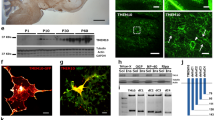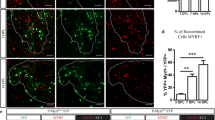Abstract
The discoidin domain receptor (DDR1) is highly expressed in oligodendrocytes during the neurodevelopmental myelination process and is genetically associated to schizophrenia. In this study, we aimed to further assess the involvement of DDR1 in both remyelination and oligodendrocyte differentiation. In the mouse model of demyelination–remyelination induced by oral administration of cuprizone, in situ hybridization showed an upregulation of the DDR1 gene in three different white matter areas (corpus callosum, dorsal fornix, and external capsule) during the remyelination period. Moreover, real time reverse transcriptase polymerase chain reaction showed that the increase in DDR1 messenger RNA (mRNA) was strongly correlated with the number of DDR1-positive cells in the corpus callosum (Spearman coefficient = 0.987, P = 0.013). Cells positive for DDR1 mRNA were also positive for oligodendrocyte markers (OLIG2, carnosine, and APC) but not for markers of oligodendrocyte precursors (NG2), myelin markers (CNPase), microglia (CD11b), or reactive glia (GFAP). Differentiation of a human oligodendroglial cell line, HOG16, was associated with an increase in mRNA expression of DDR1 and several myelin proteins (MBP and MOBP) but not other proteins (APC and CNPase). Here, we demonstrate that DDR1 is upregulated in vitro and in vivo when oligodendrocyte myelinating machinery is activated. Further studies are needed to identify the specific molecular pathway.




Similar content being viewed by others
References
Abdulhussein, R., McFadden, C., Fuentes-Prior, P., & Vogel, W. F. (2004). Exploring the collagen-binding site of the DDR1 tyrosine kinase receptor. The Journal of Biological Chemistry, 279, 31462–31470. doi:10.1074/jbc.M400651200.
Agarwal, G., Mihai, C., & Iscru, D. F. (2007). Interaction of discoidin domain receptor 1 with collagen type 1. Journal of Molecular Biology, 367, 443–455. doi:10.1016/j.jmb.2006.12.073.
Arnett, H. A., Mason, J., Marino, M., Suzuki, K., Matsushima, G. K., & Ting, J. P. (2001). TNF alpha promotes proliferation of oligodendrocyte progenitors and remyelination. Nature Neuroscience, 4, 1116–1122. doi:10.1038/nn738.
Arnett, H. A., Wang, Y., Matsushima, G. K., Suzuki, K., & Ting, J. P. (2003). Functional genomic analysis of remyelination reveals importance of inflammation in oligodendrocyte regeneration. The Journal of Neuroscience, 23, 9824–9832.
Baumann, N., & Pham-Dinh, D. (2001). Biology of oligodendrocyte and myelin in the mammalian central nervous system. Physiological Reviews, 81, 871–927.
Bhatt, R. S., Tomoda, T., Fang, Y., & Hatten, M. E. (2000). Discoidin domain receptor 1 functions in axon extension of cerebellar granule neurons. Genes & Development, 14, 2216–2228. doi:10.1101/gad.821600.
Buntinx, M., Vanderlocht, J., Hellings, N., et al. (2003). Characterization of three human oligodendroglial cell lines as a model to study oligodendrocyte injury: morphology and oligodendrocyte-specific gene expression. Journal of Neurocytology, 32, 25–38. doi:10.1023/A:1027324230923.
Chang, A., Tourtellotte, W. W., Rudick, R., & Trapp, B. D. (2002). Premyelinating oligodendrocytes in chronic lesions of multiple sclerosis. The New England Journal of Medicine, 346, 165–173. doi:10.1056/NEJMoa010994.
Davis, K. L., Stewart, D. G., Friedman, J. I., et al. (2003). White matter changes in schizophrenia: evidence for myelin-related dysfunction. Archives of General Psychiatry, 60, 443–456. doi:10.1001/archpsyc.60.5.443.
Franco-Pons, N., Torrente, M., Colomina, M. T., & Vilella, E. (2007). Behavioral deficits in the cuprizone-induced murine model of demyelination/remyelination. Toxicology Letters, 169, 205–213. doi:10.1016/j.toxlet.2007.01.010.
Franco-Pons, N., Virgos, C., Vogel, W. F., et al. (2006). Expression of discoidin domain receptor 1 during mouse brain development follows the progress of myelination. Neuroscience, 140, 463–475. doi:10.1016/j.neuroscience.2006.02.033.
Franklin, R. J., & Hinks, G. L. (1999). Understaning CNS remyelination: clues from developmental and regeneration biology. Journal of Neuroscience Research, 58, 207–213. doi:10.1002/(SICI)1097-4547(19991015)58:2<207::AID-JNR1>3.0.CO;2-1.
Hiremath, M. M., Saito, Y., Knapp, G. W., Ting, J. P., Suzuki, K., & Matsushima, G. K. (1998). Microglial/macrophage accumulation during cuprizone-induced demyelination in C57BL/6 mice. Journal of Neuroimmunology, 92, 38–49. doi:10.1016/S0165-5728(98)00168-4.
Hou, G., Vogel, W. F., & Bendeck, M. P. (2002). Tyrosine kinase activity of discoidin domain receptor 1 is necessary for smooth muscle cell migration and matrix metalloproteinase expression. Circulation Research, 90, 1147–1149. doi:10.1161/01.RES.0000022166.74073.F8.
Jonsson, M., & Andersson, T. (2001). Repression of Wnt-5a impairs DDR1 phosphorylation and modifies adhesion and migration of mammary cells. Journal of Cell Science, 114, 2043–2053.
Kamohara, H., Yamashiro, S., Galligan, C., & Yoshimura, T. (2001). Discoidin domain receptor 1 isoform-a (DDR1alpha) promotes migration of leukocytes in three-dimensional collagen lattices. The FASEB Journal, 15, 2724–2726.
Liebetanz, D., & Merkler, D. (2006). Effects of commissural de- and remyelination on motor skill behaviour in the cuprizone mouse model of multiple sclerosis. Experimental Neurology, 202, 217–224. doi:10.1016/j.expneurol.2006.05.032.
Ligon, K. L., Fancy, S. P. J., Franklin, R. J. M., & Rowitch, D. H. (2006). Olig gene function in CNS development and disease. Glia, 54, 1–10. doi:10.1002/glia.20273.
Mason, J. L., Jones, J. J., Taniike, M., Morell, P., Suzuki, K., & Matsushima, G. K. (2000). Mature oligodendrocyte apoptosis precedes IGF-1 production and oligodendrocyte progenitor accumulation and differentiation during demyelination/remyelination. Journal of Neuroscience Research, 61, 251–262. doi:10.1002/1097-4547(20000801)61:3<251::AID-JNR3>3.0.CO;2-W.
Mason, J. L., Langaman, C., Morell, P., Suzuki, K., & Matsushima, G. K. (2001). Episodic demyelination and subsequent remyelination within the murine central nervous system: changes in axonal calibre. Neuropathology and Applied Neurobiology, 27, 50–58. doi:10.1046/j.0305-1846.2001.00301.x.
Mason, J. L., Toews, A., Hostettler, J. D., et al. (2004). Oligodendrocytes and progenitors become progressively depleted within chronically demyelinated lesions. American Journal of Pathology, 164, 1673–1682.
Matsushima, G. K., & Morell, P. (2001). The neurotoxicant, cuprizone, as a model to study demyelination and remyelination in the central nervous system. Brain Pathology (Zurich, Switzerland), 11, 107–116.
Matsuyama, W., Faure, M., & Yoshimura, T. (2003). Activation of discoidin domain receptor 1 facilitates the maturation of human monocyte-derived dendritic cells through the TNF receptor associated factor 6/TGF-beta-activated protein kinase 1 binding protein 1 beta/p38 alpha mitogen-activated protein kinase signaling cascade. Journal of Immunology, 171, 3520–3532, Baltimore, MD.: 1950.
McInnes, L. A., & Lauriat, T. L. (2006). RNA metabolism and dysmyelination in schizophrenia. Neuroscience and Biobehavioral Reviews, 30, 551–561. doi:10.1016/j.neubiorev.2005.10.003.
Morell, P., Barrett, C. V., Mason, J. L., et al. (1998). Gene expression in brain during cuprizone-induced demyelination and remyelination. Molecular and Cellular Neurosciences, 12, 220–227. doi:10.1006/mcne.1998.0715.
Nait-Oumesmar, B., Decker, L., Lachapelle, F., Avellana-Adalid, V., Bachelin, C., & Van Evercooren, A. B. (1999). Progenitor cells of the adult mouse subventricular zone proliferate, migrate and differentiate into oligodendrocytes after demyelination. The European Journal of Neuroscience, 11, 4357–4366. doi:10.1046/j.1460-9568.1999.00873.x.
Paxinos, G., & Franklin, K. B. J. (2001). The mouse brain in stereotaxic coordinates. San Diego: Academic.
Roig, B., Virgos, C., Franco, N., et al. (2007). The discoidin domain receptor 1 as a novel susceptibility gene for schizophrenia. Molecular Psychiatry, 12, 833–841. doi:10.1038/sj.mp.4001995.
Sanchez, M. P., Tapley, P., Saini, S. S., He, B., Pulido, D., & Barbacid, M. (1994). Multiple tyrosine protein kinases in rat hippocampal neurons: isolation of Ptk-3, a receptor expressed in proliferative zones of the developing brain. Proceedings of the National Academy of Sciences of the United States of America, 91, 1819–1823. doi:10.1073/pnas.91.5.1819.
Stidworthy, M. F., Genoud, S., Suter, U., Mantei, N., & Franklin, R. J. (2003). Quantifying the early stages of remyelination following cuprizone-induced demyelination. Brain Pathology (Zurich, Switzerland), 13, 329–339.
Vogel, W., Gish, G. D., Alves, F., & Pawson, T. (1997). The discoidin domain receptor tyrosine kinases are activated by collagen. Molecular Cell, 1, 13–23. doi:10.1016/S1097-2765(00)80003-9.
Vogel, W. F., Aszodi, A., Alves, F., & Pawson, T. (2001). Discoidin domain receptor 1 tyrosine kinase has an essential role in mammary gland development. Molecular and Cellular Biology, 21, 2906–2917. doi:10.1128/MCB.21.8.2906-2917.2001.
Walterfang, M., Wood, S. J., Velakoulis, D., & Pantelis, C. (2006). Neuropathological, neurogenetic and neuroimaging evidence for white matter pathology in schizophrenia. Neuroscience and Biobehavioral Reviews, 30, 918–948. doi:10.1016/j.neubiorev.2006.02.001.
Wang, C. Z., Hsu, Y. M., & Tang, M. J. (2005). Function of discoidin domain receptor I in HGF-induced branching tubulogenesis of MDCK cells in collagen gel. Journal of Cellular Physiology, 203, 295–304. doi:10.1002/jcp.20227.
Walterfang, M., Wood, S. J., Velakoulis, D., & Pantelis, C. (2006). Neuropathological, neurogenetic and neuroimaging evidence for white matter pathology in schizophrenia. Neuroscience and Biobehavioral Reviews, 30, 918–948. doi:10.1016/j.neubiorev.2006.02.001.
Xiao, L., Xu, H., Zhang, Y., et al. (2008). Quetiapine facilitates oligodendrocyte development and prevents mice for myelin breakdown and behavioral changes. Molecular Psychiatry, 13(7), 897–708. doi:10.1038/sj.mp.4002064.
Zawadzka, M., & Franklin, R. J. (2007). Myelin regeneration in demyelinating disorders: new developments in biology and clinical pathology. Current Opinion in Neurology, 20, 294–298. doi:10.1097/WCO.0b013e32813aee7f.
Zerlin, M., Julius, M. A., & Goldfarb, M. (1993). NEP: a novel receptor-like tyrosine kinase expressed in proliferating neuroepithelia. Oncogene, 8, 2731–2739.
Acknowledgments
This work was supported by the Spanish Ministry of Health (Fondo the investigación Sanitaria PI02/0498) and the Stanely Research Institute (#03R-392 and #05R-896).
Author information
Authors and Affiliations
Corresponding author
Rights and permissions
About this article
Cite this article
Franco-Pons, N., Tomàs, J., Roig, B. et al. Discoidin Domain Receptor 1, a Tyrosine Kinase Receptor, is Upregulated in an Experimental Model of Remyelination and During Oligodendrocyte Differentiation In Vitro. J Mol Neurosci 38, 2–11 (2009). https://doi.org/10.1007/s12031-008-9151-x
Received:
Accepted:
Published:
Issue Date:
DOI: https://doi.org/10.1007/s12031-008-9151-x




